Top 10 AI Prompting Techniques: Master AI Communication
Artificial Intelligence (AI) is changing the way we work, create, and communicate. One of the most powerful ways to use AI is through prompting—giving clear instructions to AI tools like ChatGPT to get the best results. However, not all prompts give good answers. Some work better than others because they are more detailed, structured, or creative.
In this guide, we will explore the top 10 AI prompting techniques that can help you get better responses. Whether you are a beginner or already using AI, these simple but effective techniques will improve your interaction with AI and make it more useful for your needs.
What is AI prompting, and How does AI Prompting work?
AI prompting is the way we give instructions to artificial intelligence so it can provide the best possible response. When we type a question or command into an AI tool, we are prompting it to generate an answer. These tools use machine learning and deep learning to understand and process our words.
A key part of AI prompting is natural language processing (NLP), which helps AI understand human language. With NLP, AI can recognize different sentence structures, tones, and meanings to respond more accurately.
To get better results, people often use prompt templates—pre-designed formats that guide AI in giving clearer and more useful answers. These templates help structure prompts for better accuracy.
By gaining a deeper understanding of how AI prompting works, you can take control of your interactions with AI tools. Whether you’re writing, researching, or brainstorming ideas, mastering these techniques empowers you to make AI more helpful and efficient for your specific needs.
Why is it important to get your AI prompts right?
Getting your AI prompts right is of utmost importance. It's not just about getting the best answers from conversational AI tools like ChatGPT. It's about ensuring that the way you structure your words when you type a question or command is clear and concise, enabling the AI to understand and respond accurately. Your responsibility in this process is crucial, as an unclear prompt may lead to an incomplete or incorrect answer.
Good prompt writing helps you get accurate, useful, and well-organized responses. For example, if you ask, "Tell me about marketing," the AI may answer very broadly. But if you use a better prompt design, such as, "Explain three digital marketing strategies for small businesses," you will get a more detailed and relevant response.
AI communication is also important for businesses, students, and content creators. If a company uses AI for customer support, clear AI interaction ensures that customers get the right information. For instance, if someone asks an AI chatbot, "How do I return a product?" a well-structured prompt in the chatbot’s system will provide a direct and helpful answer.
When prompting AI, always give enough details to guide the response. Instead of saying, "Write about healthy eating," you can say, "Write a 200-word blog on healthy eating habits for teenagers." This makes the AI’s answer more specific and useful.
Top 10 AI Prompting Techniques for Better Responses
To get the best results from AI tools like ChatGPT, Claude AI, Gemini AI, GPT-3, and DALL-E 2, you need to use the right AI prompting techniques. Here are the top 10 methods that help improve AI responses:
1. Zero-Shot Prompting
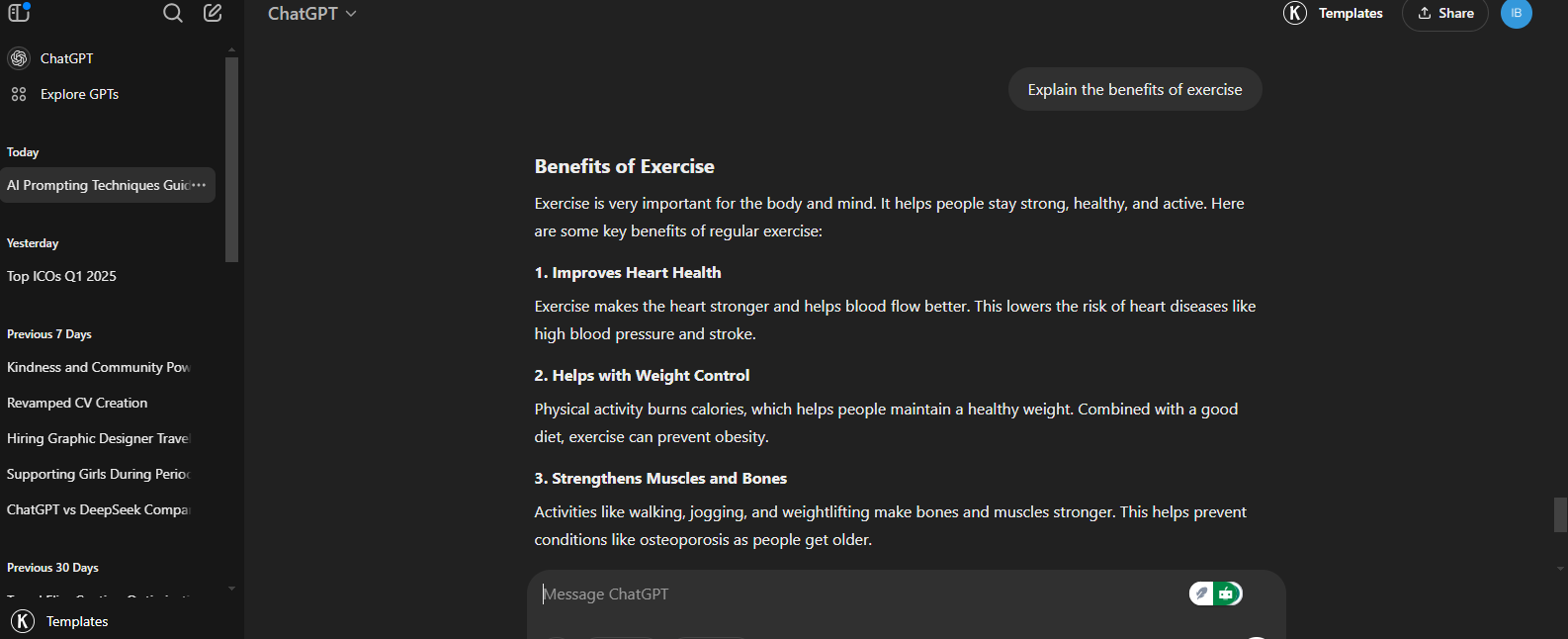
Zero-shot prompting is when you ask an AI system a question or give it a task without providing any example. The AI uses its existing knowledge and training to generate a response. This method works well when you need quick answers for common or general topics.
For example, if you ask, “Explain the benefits of exercise,” the AI will pull from its learned information and provide a general response about health benefits, fitness, and mental well-being.
However, zero-shot prompting has limitations. Since the AI does not have an example to follow, the response may lack detail or structure. It might give broad information rather than a specific, well-organized answer. This can be a problem when you need a very precise or technical response.
For instance, if you ask, “Write a sales pitch for a new smartphone,” the AI might give a basic pitch but not one that matches a specific audience or style.
Zero-shot prompting is useful for simple requests and quick information, but for complex tasks, other prompting techniques like one-shot or few-shot learning may give better results.
2. One-Shot Prompting
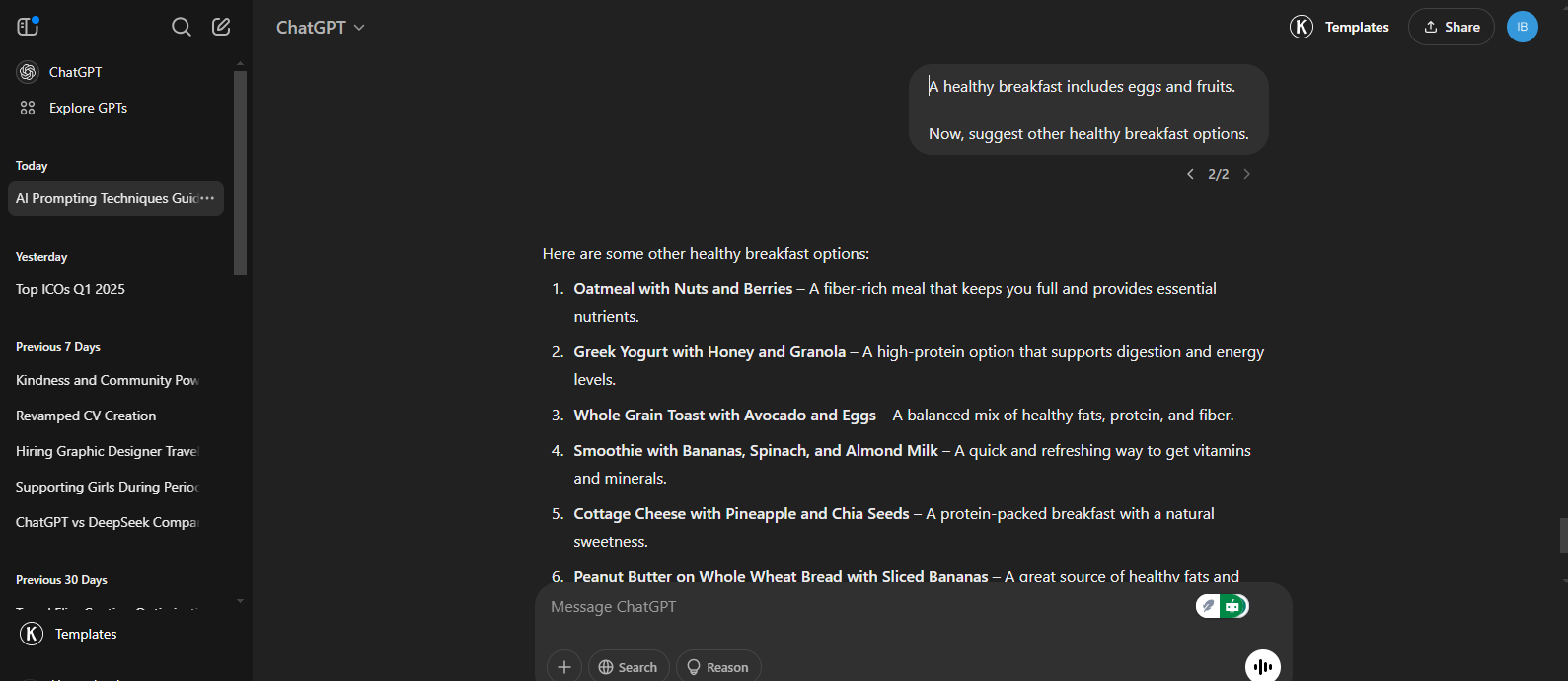
One-shot prompting is a technique where you give AI one example before asking it to complete a task. This example helps the AI understand what kind of response you expect. Instead of letting AI guess, you provide a clear guide so that the response is more accurate and relevant.
For instance, if you ask AI, “Suggest a healthy breakfast,” the answer may be too broad or unclear. However, if you first give an example, the AI will follow the pattern.
Example: “A healthy breakfast includes eggs and fruits. Now, suggest another healthy breakfast option.”
With this prompt, AI understands that the response should be about healthy foods and will provide a similar suggestion.
This method is useful for many tasks, such as writing, customer service, and research. If you want AI to generate product descriptions, you can give one example first.
Example: “This phone has a sleek design and long battery life. Now, describe another smartphone.”
Using one-shot prompting improves AI communication and ensures that AI follows the right structure. This technique is especially helpful when using GPT-3 prompts or other AI tools for writing, marketing, or answering customer questions.
3. Few-Shot Learning
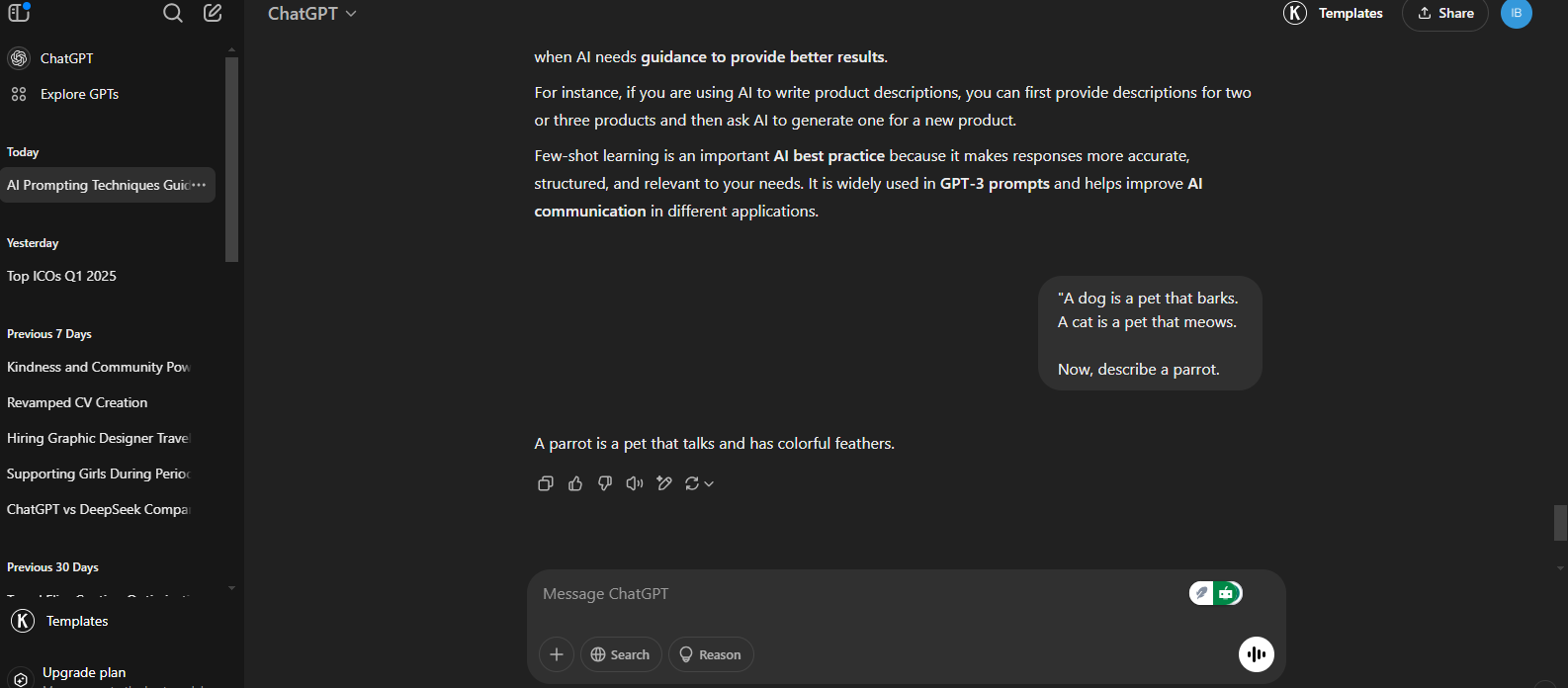
Few-shot learning is a technique in which you give an AI multiple examples before asking it to generate a response. This helps the AI understand patterns and improve accuracy. Instead of making the AI guess what you want, you show it how to respond by providing a few examples.
For example, if you want AI to describe animals correctly, you can use this approach:
Example:
"A dog is a pet that barks. A cat is a pet that meows. Now, describe a parrot."
Since the AI has already seen how to describe animals, it will likely say something like:
"A parrot is a pet that talks and has colorful feathers."
This method works well for tasks like writing, answering questions, or completing sentences. It is useful when AI needs guidance to provide better results.
For instance, if you are using AI to write product descriptions, you can first provide descriptions for two or three products and then ask AI to generate one for a new product.
Few-shot learning is an important AI best practice because it makes responses more accurate, structured, and relevant to your needs. It is widely used in GPT-3 prompts and helps improve AI communication in different applications.
4. Information Retrieval
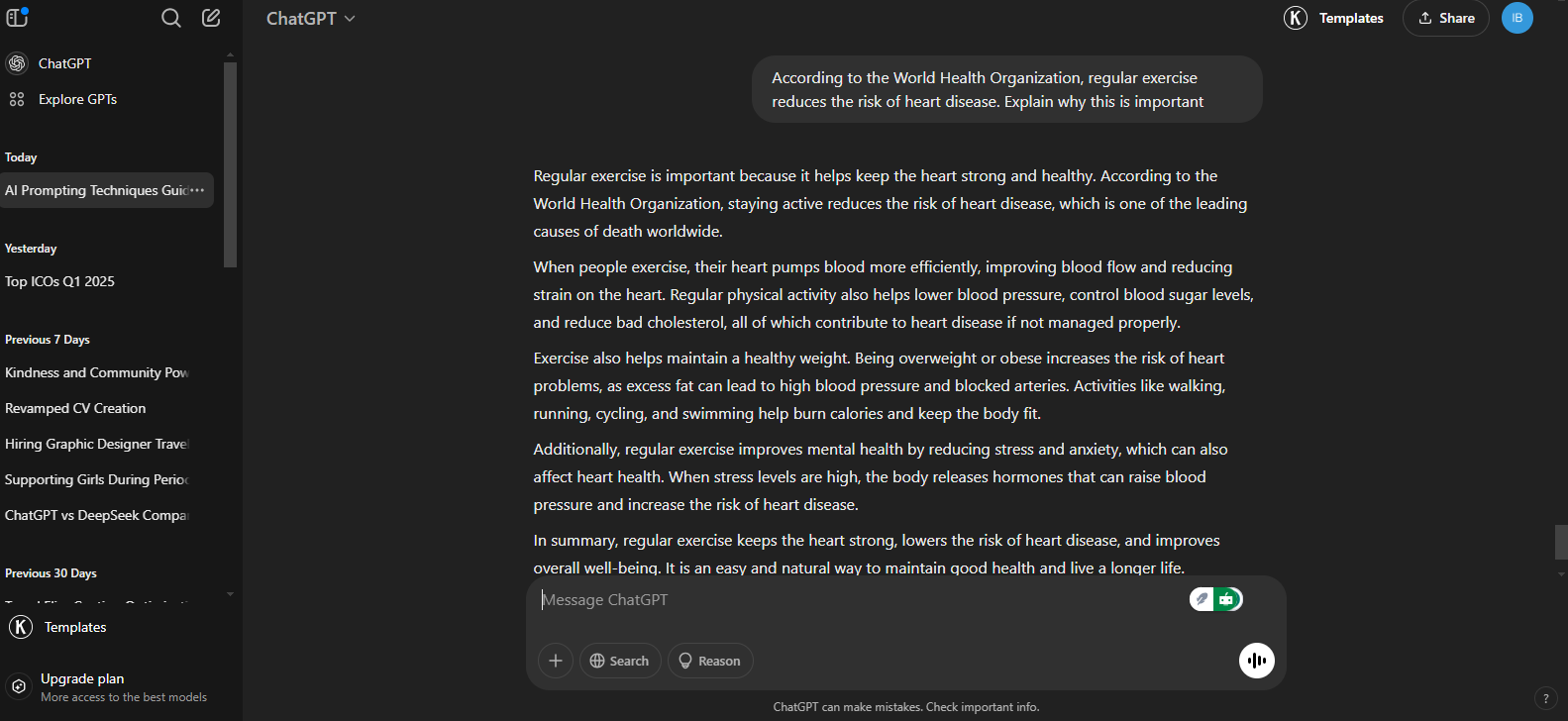
AI tools like ChatGPT and GPT-3 use large amounts of data to generate responses. However, sometimes they may not provide the most up-to-date or accurate information. This is where information retrieval becomes useful. Instead of depending only on the AI’s memory, this technique adds facts, data, or references to the prompt to improve accuracy.
For example, instead of simply asking, “Why is exercise important?” you can provide a fact within the prompt:
“According to the World Health Organization, regular exercise reduces the risk of heart disease. Explain why this is important.”
By including reliable data, AI can generate a more specific and fact-based response rather than a general answer.
This technique is helpful in fields like health, science, finance, and history, where accuracy is critical. For instance, a student writing a research paper on climate change could prompt AI with:
“According to NASA, global temperatures have increased by 1.1°C since 1880. Explain the effects of this temperature rise.”
This ensures that AI builds its response on real-world data, making the answer more valuable.
Using information retrieval in your prompts improves AI communication, helps generate credible responses, and ensures better writing, research, and decision-making results.
5. Context Usage

Context usage means giving background information when asking AI a question. This helps the AI understand exactly what you want and respond better. Without enough context, AI may give a vague or incorrect answer.
For example, if you ask, “Summarize this book,” the AI may not know which book you are referring to. However, if you say, “Summarize the book ‘Atomic Habits’ and explain its main lessons,” the AI knows which book to summarize and what specific details to focus on. This makes the response clearer and more useful.
Context is also important in GPT-3 prompts when asking AI to generate text, solve problems, or provide recommendations. If you are asking AI for business advice, you can add details like the industry, target audience, or specific challenges you face.
For example, instead of saying, “Give me marketing tips,” you can say, “Give me five digital marketing tips for a small clothing business on Instagram.” This extra context helps AI give more targeted and relevant suggestions.
By using context in AI prompts, you can improve AI responses for research, writing, and decision-making. This is one of the best AI prompting techniques for getting better results.
Read: Ultimate Guide-to-becoming-a-prompt-engineering-specialist
6. Creative Writing

Creative writing prompts help AI generate interesting and engaging content. If you want AI to write a story, poem, or script, you need to structure your prompt in a creative way. The better your instructions, the better the AI’s response will be.
For example, instead of saying, “Write a story,” you can make it more detailed: “Write a short story about a lost astronaut who finds a hidden planet.” This gives the AI a clear direction and makes the story more focused.
This method is very useful for DALL-E 2 prompts, where AI generates images based on creative text descriptions. For example, instead of typing “Draw a dog,” you can say, “Create an image of a golden retriever wearing sunglasses at the beach.” This makes the output more specific and fun.
Creative writing prompts are helpful for authors, marketers, and content creators. If you need blog posts, scripts, or advertisements, structuring prompts well can help AI generate better-quality content.
If the AI’s response is not creative enough, you can improve it by adding more details or asking for a different style. For example, “Rewrite this story in a funny tone” or “Make this poem sound emotional.”
By using structured and detailed prompts, you can make AI-generated stories, articles, and images more interesting and engaging.
7. Prompt Reframing
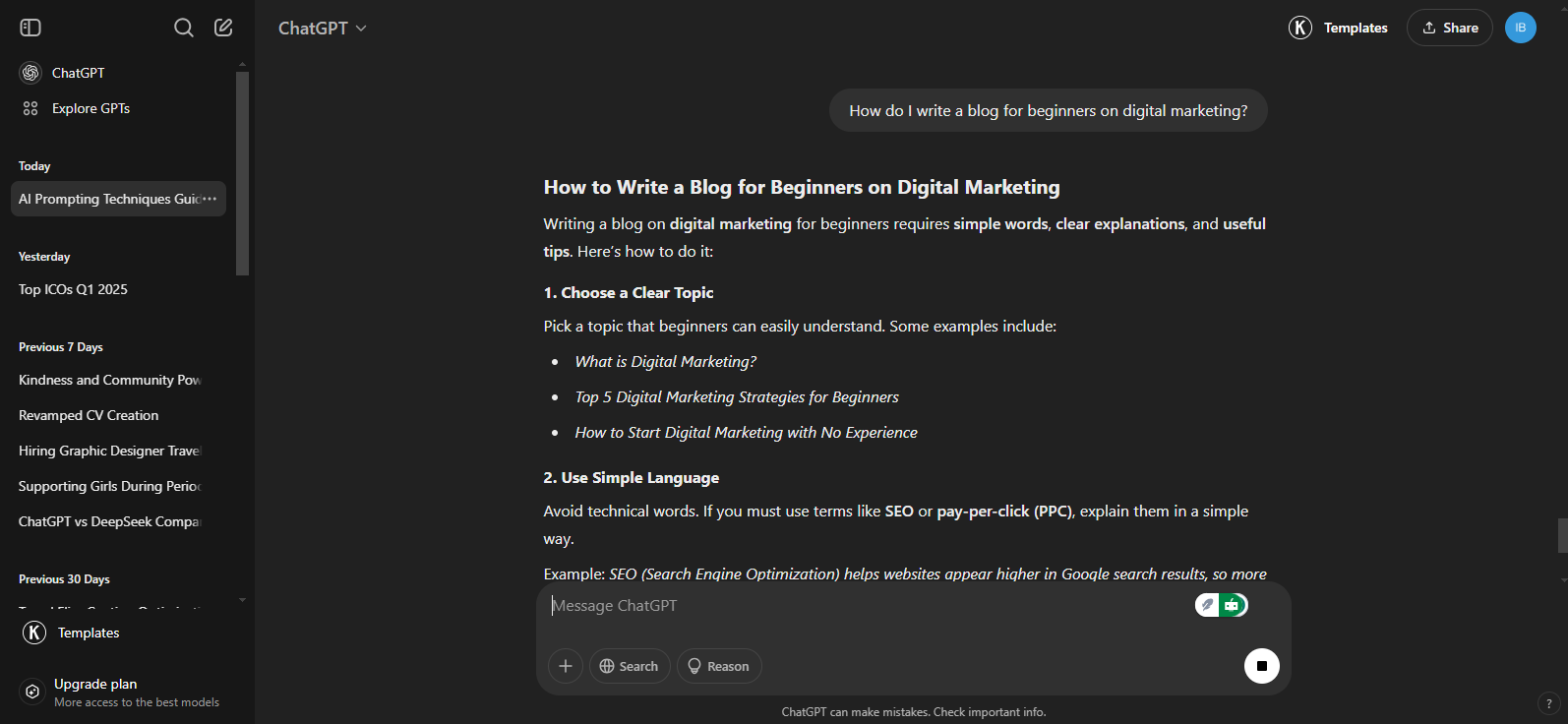
Sometimes, when you ask AI a question, the response may not be clear, detailed, or relevant. Prompt reframing means changing the wording of your question to help AI understand better and give a more useful answer.
AI works by analyzing the words in your prompt and predicting the best response. If a prompt is too broad or unclear, AI might give a vague answer. By rephrasing the prompt, you can guide AI to focus on what you really need.
For example, if you type “Tell me about AI,” the response might be too general. Instead, if you say “Explain AI like I am 10 years old,” the AI will simplify the answer, making it easier to understand.
Another example: If you ask “How do I write a blog?” the answer may be basic. But if you reframe it as “How do I write a blog for beginners on digital marketing?” the AI will provide a more specific and useful response.
Prompt reframing is one of the AI best practices that improves AI-generated content. Whether you are using AI for research, content writing, or problem-solving, rewording your prompt can help you get clearer, more accurate, and more detailed responses.
8. Chain of Thought Prompting
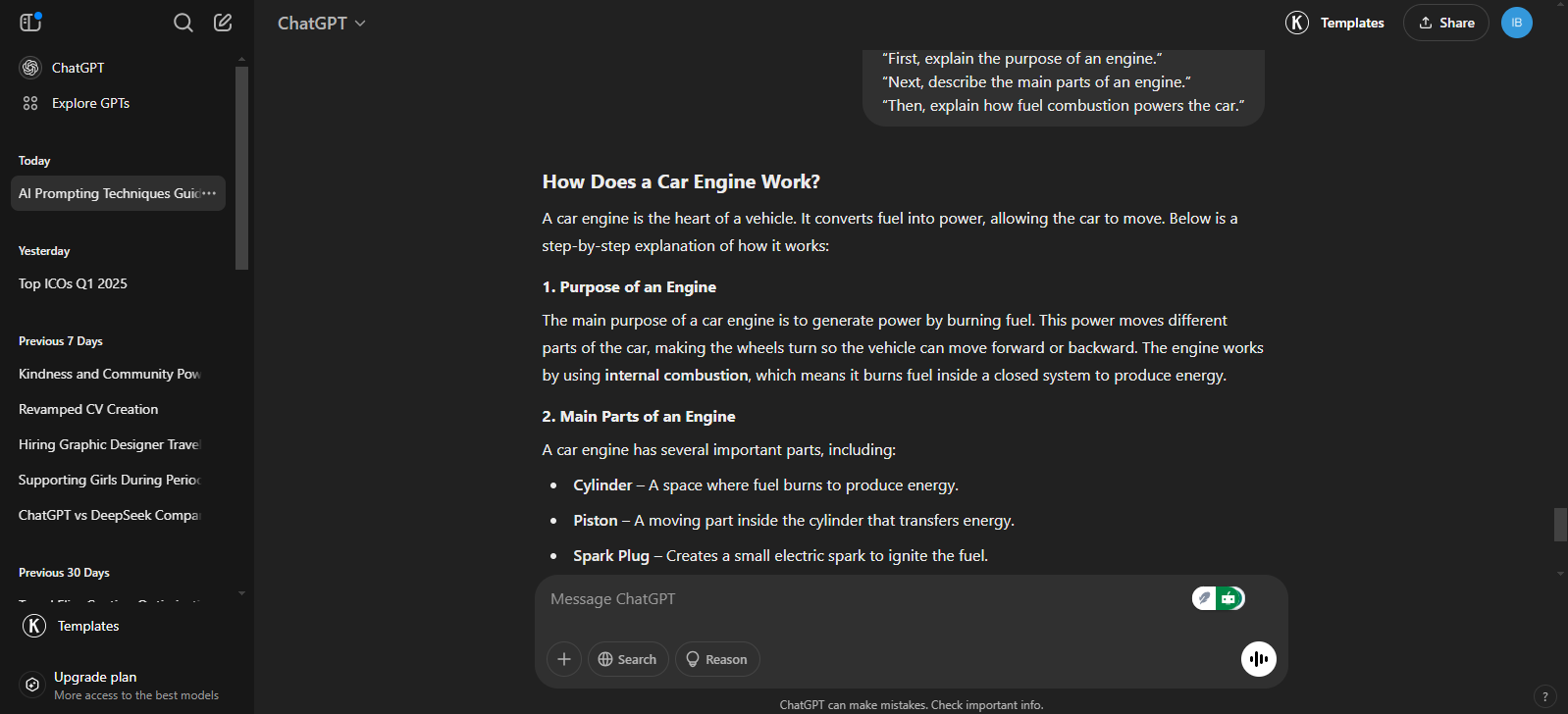
Chain of thought prompting is a method that helps AI think step by step to improve its reasoning. Instead of expecting AI to give an answer immediately, you guide it through the process by breaking down the problem into smaller steps. This technique is useful for solving complex problems, improving accuracy, and making AI responses more logical.
For example, if you ask AI, “Solve 25 × 4,” it may just give the final answer: 100. However if you use chain of thought prompting, you can guide AI through the steps like this:
“First, break 25 into (20 + 5).”
“Now multiply each part by 4.”
“20 × 4 = 80, and 5 × 4 = 20.”
“Now add 80 + 20.”
“The final answer is 100.”
By following this method, AI provides a clearer and more structured response.
This technique is especially useful for math problems, logical reasoning, and coding tasks. For instance, if you want AI to explain a difficult concept, like how a car engine works, instead of asking, “How does a car engine work?”, you can say:
“First, explain the purpose of an engine.”
“Next, describe the main parts of an engine.”
“Then, explain how fuel combustion powers the car.”
This step-by-step approach ensures AI gives a well-organized and easy-to-understand answer.
9. Iteration
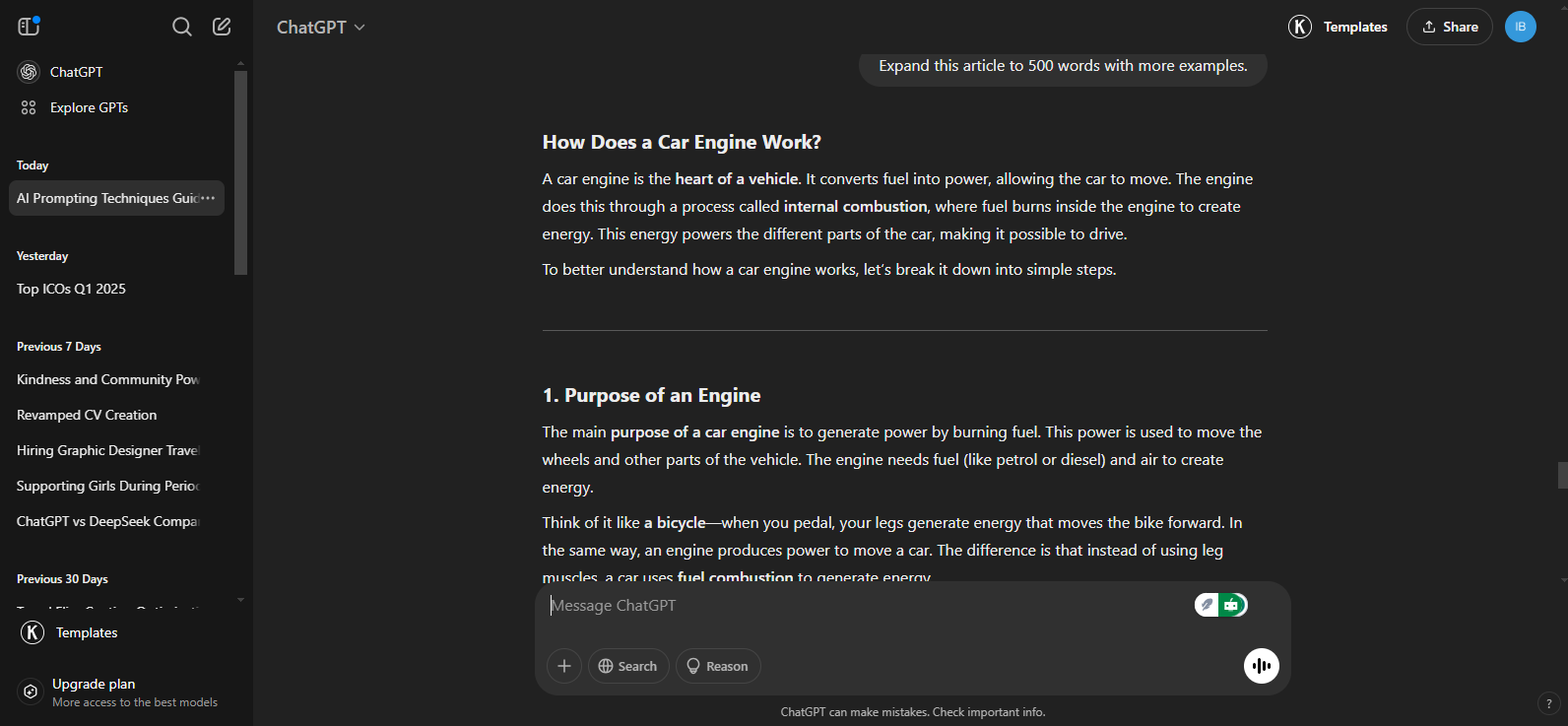
Iteration means improving your AI prompt by changing and refining it multiple times until you get the best response. AI does not always give the perfect answer on the first try. If the response is too general, unclear, or missing details, you can adjust your prompt to guide AI toward a better answer.
For example, if you ask, "Give me a blog outline on digital marketing," the AI might provide a basic structure with just a few points. If you need more details, you can refine your prompt by saying, "Make the outline more detailed with subheadings and key points under each section." This will make AI add more useful information.
Iteration is useful in many areas, such as content writing, coding, and research. If an AI-generated article is too short, you can modify your prompt to say, "Expand this article to 500 words with more examples."
This method also helps in creative writing. If an AI-generated story is not interesting enough, you can ask, "Rewrite this with more emotion and vivid descriptions."
By using iteration, you can improve AI accuracy over time, making responses clearer, more detailed, and useful. It is one of the best ways to fine-tune AI communication and get high-quality results.
10. Prompt Chaining & Content Expansion
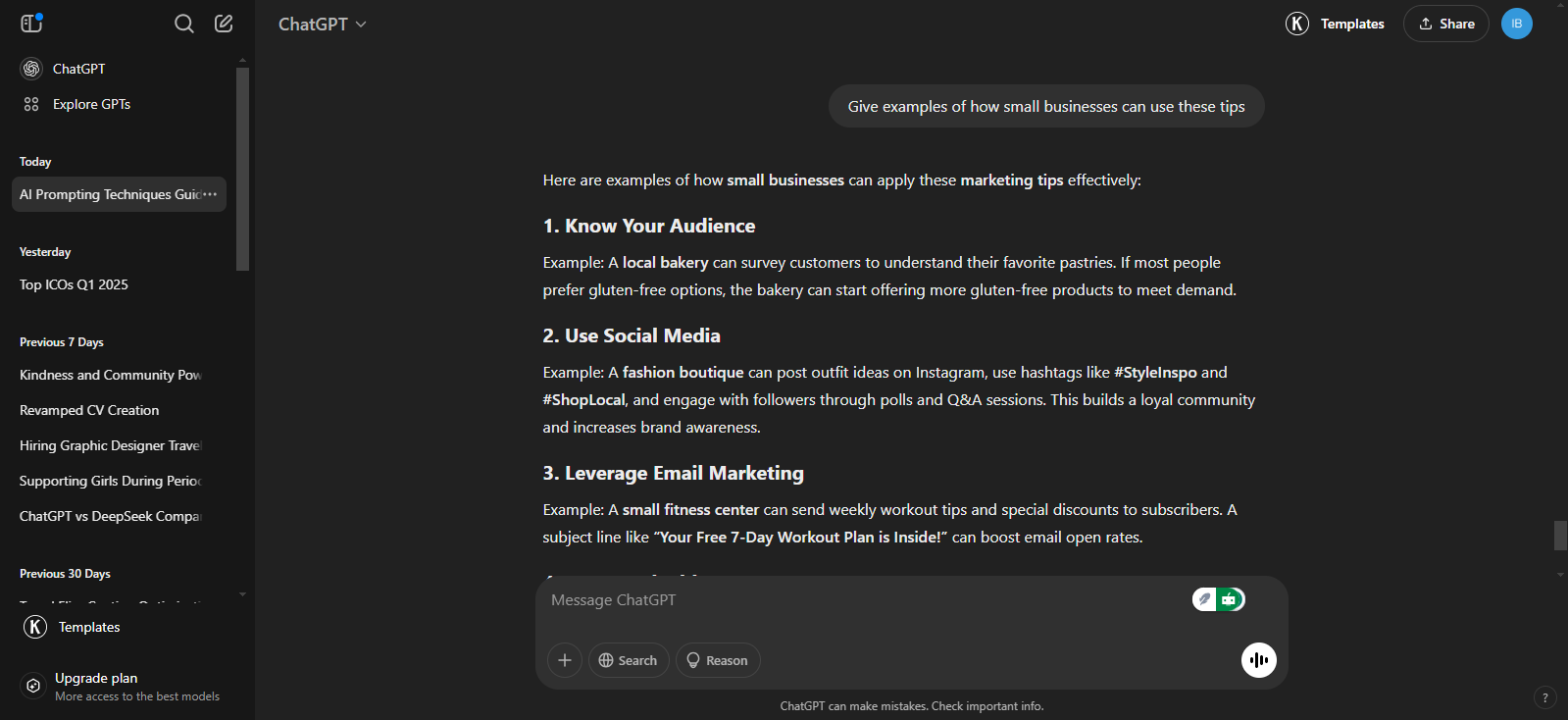
Prompt chaining is a method where multiple prompts are used together to create a complete and detailed response. Instead of asking AI one big question, you break it down into smaller parts, guiding the AI step by step. This makes the response more structured, detailed, and accurate.
For example, if you want AI to write about marketing, you can start with a simple prompt:
“List 5 marketing tips.”
Once AI provides the list, you can then ask follow-up questions to expand on each point:
“Explain each tip in detail.”
“Give examples of how small businesses can use these tips.”
This technique is very useful for content expansion because it allows AI to develop longer, well-organized, and more informative responses.
Prompt chaining is especially helpful in research, storytelling, and DALL-E 2 prompts, where you may need AI to generate images based on a detailed description. Instead of asking for a generic image, you can refine the request step by step.
By following this AI best practice, you can improve GPT-3 prompts, create more engaging content, and ensure AI responses are rich in detail. Whether for writing, research, or creativity, prompt chaining helps you get better results with AI.
Final words
AI is a powerful tool, but you must learn how to prompt it correctly to get the best results. This guide has explained 10 effective AI prompting techniques that can help you improve how AI responds to your questions. When you understand prompting deeply, the end results will be much better—clearer, more accurate, and more useful. This will encourage individuals, businesses, and institutions to fully embrace AI because they will see its true potential.
One of the main reasons some people hesitate to use AI is because they feel it lacks human emotions. However, when you use the right prompting techniques, AI can produce more natural, emotional, and engaging responses. You can make AI content more relatable and human-like by applying methods like prompt chaining, creative writing, and chain-of-thought prompting.
Mastering these techniques will help you work smarter, create better content, and unlock AI’s full power.